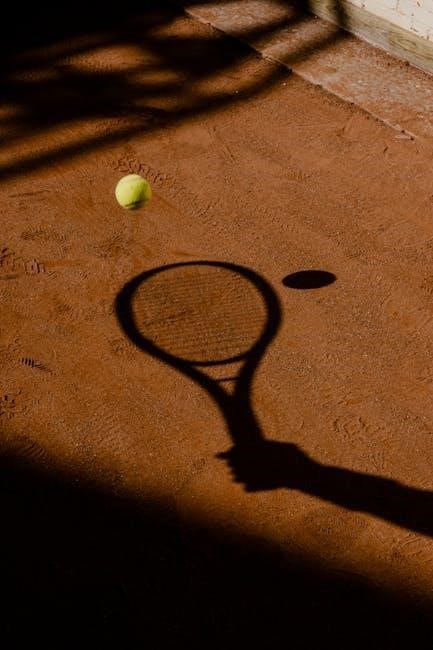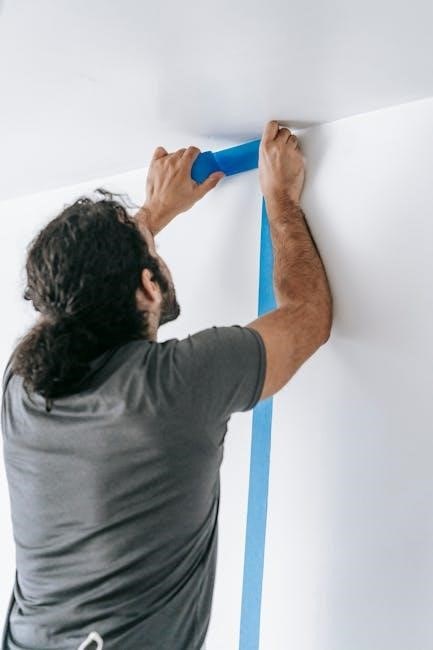Discover the importance of proper grip size for optimal performance and comfort. Learn how to measure, choose, and maintain your grip effectively for a better game.

Why Grip Size Matters in Tennis
Proper grip size ensures control, comfort, and reduces injury risk. A correct fit enhances performance, while an incorrect size can hinder play and lead to discomfort or fatigue during matches.
Impact on Comfort and Performance
A properly sized grip ensures optimal comfort and control, allowing for precise strokes and reduced fatigue. A grip too small can cause discomfort, while one too large may limit maneuverability. Proper fit prevents slippage, enhancing performance and consistency. Incorrect sizing can lead to hand strain or impaired technique, affecting overall play. The right grip size balances feel and functionality, enabling players to perform at their best without sacrificing comfort or control during intense matches.
Consequences of Incorrect Grip Size
Incorrect grip size can lead to discomfort, blisters, and reduced control. A grip too small may cause hand strain, while one too large can hinder precise strokes. This imbalance increases fatigue and raises the risk of injuries like wrist strain or tendonitis. Proper sizing is crucial for optimal performance, ensuring comfort and minimizing the risk of long-term damage to your hands and wrists.

How to Measure Your Tennis Racquet Grip Size
Measure by aligning your index finger knuckle with the racquet’s bevel or using a ruler. Ensure accuracy for optimal comfort and performance, especially for juniors.
The Index Finger Test Method
Hold the racquet with an eastern forehand grip. Align your index finger knuckle with the top-right bevel. If the space between your ring finger and palm fits your index finger snugly, the grip size is correct. For a precise fit, ensure the finger can move slightly without feeling too tight or loose. This method ensures comfort and control, crucial for optimal performance on the court. Proper alignment helps prevent discomfort and injury, making it a reliable measuring technique for players of all levels.
Using a Ruler for Measurement
Place the ruler on the widest part of the racquet handle. Measure the circumference to determine your grip size. The length should fall between 4 and 4 5/8 inches, corresponding to standard sizes 0 to 5. Use this precise method to find your ideal fit. While this approach provides accurate measurements, personal comfort and feel are equally important. This technique ensures a reliable starting point for players seeking the perfect grip size for their game.
Measuring Grip Size for Junior Players
For junior players, measuring grip size is crucial for proper development. Use the same ruler method as adults, but consider smaller hands. The handle should fit comfortably, allowing the index finger to rest between the ring finger and palm. Junior racquets often come in smaller grip sizes, typically 0-3. Ensure the grip isn’t too large, as it can hinder control. Proper fit helps young players maintain good technique and prevents discomfort during play.

Understanding Standard Grip Sizes
Standard grip sizes range from 0 to 5, measured in inches. Most adults use size 3 (4 inches). Proper fit ensures comfort and control.
Grip Size Options and Their Meanings
Grip sizes range from 0 to 5, corresponding to specific measurements in inches. Size 0 is the smallest, while size 5 is the largest. Most adults use size 3 (4 inches), offering a balance of comfort and control. Junior players often prefer smaller sizes, such as 0 or 1, to fit their smaller hands. The right size ensures proper grip feel, preventing discomfort or loss of control. While size 3 is standard, personal preference and hand size play a crucial role in selection.
Factors Influencing Grip Size Choice
Hand size and finger length are primary factors in choosing grip size. Players with larger hands may prefer a larger grip for comfort, while smaller hands benefit from a smaller size. Playing style also matters; those with a strong topspin may opt for a slightly larger grip for better control. Personal comfort and feel are crucial, as an incorrect size can lead to discomfort or performance issues. Ultimately, the grip should fit naturally, allowing optimal control and maneuverability during play.

Benefits of the Right Grip Size
The right grip size enhances comfort and control, allowing for precise shots and better maneuverability. It reduces the risk of injury and improves overall performance, ensuring a more enjoyable game;
Enhanced Comfort and Control
A well-fitted grip size ensures comfort and control, reducing fatigue during long matches. It allows for a secure hold without strain, enabling precise shots and consistent performance. Proper grip size prevents slipping and adjusts to your hand’s natural shape, providing stability and confidence. This tailored fit enhances your ability to maneuver the racquet smoothly, delivering accurate and powerful strokes. By optimizing comfort and control, the right grip size elevates your overall playing experience and helps you perform at your best.
Reducing Risk of Injury
The right grip size is crucial for preventing injuries like tennis elbow and wrist strain. A grip that’s too small forces tighter holds, leading to hand and wrist strain. Conversely, a grip that’s too large can cause awkward swings and improper form, increasing injury risk. Proper fit ensures natural movement and technique, reducing unnecessary pressure on joints. By optimizing grip size, players maintain control and minimize the likelihood of overuse injuries, promoting long-term comfort and performance.
The Role of Overgrips in Grip Size
Overgrips add an extra layer to the racquet handle, increasing grip size and providing better control and sweat absorption; They are ideal for players needing a larger grip without replacing the original handle.
How Overgrips Affect Grip Size
Overgrips add an extra layer to the racquet handle, increasing grip size by approximately 1/16 inch. They enhance control, comfort, and sweat absorption. Using multiple overgrips can further customize the size. However, overgrips should not be relied upon to significantly alter grip size, as excessive layers may hinder performance. They are ideal for minor adjustments, offering a practical solution for players seeking a slightly larger grip without changing the original handle. This method is both cost-effective and easily reversible.

When to Use Overgrips
Overgrips are ideal for players needing a slightly larger grip size without altering the original handle. They are perfect for adding comfort, reducing sweat, and enhancing control. Use them if you prefer a thicker handle or experience discomfort with your current size. Overgrips are also great for temporary adjustments or when experimenting with different sizes. They provide a cost-effective, reversible solution, making them a versatile option for tailoring your racquet’s feel to your preferences.

Customizing Your Grip Size
Customize your grip size using heat-shrink sleeves or overgrips. Sleeves provide a permanent fit, while overgrips offer a temporary, adjustable solution. Both enhance comfort and control.
Using Heat-Shrink Sleeves
Heat-shrink sleeves are a popular method to customize your racquet’s grip size. They are applied by heating the sleeve, which then conforms to the handle, creating a snug fit. Unlike overgrips, sleeves provide a more permanent solution, offering consistent grip size without the bulk. Heat-shrink sleeves are ideal for players seeking a tailored feel. They can be trimmed for precise sizing and come in various thicknesses. This option is durable and maintains its shape well over time.
Combining Overgrips and Sleeves
Combining overgrips and heat-shrink sleeves offers a customizable grip solution. Sleeves provide a base layer, increasing grip size permanently, while overgrips add cushioning and tackiness. This method is ideal for players seeking a thicker handle without sacrificing feel. The sleeve ensures consistent sizing, while the overgrip enhances comfort and control. Many players prefer this combination for its adaptability, allowing adjustments to meet individual preferences. It’s a practical way to achieve a personalized grip setup for optimal performance on the court.

Comparing Different Grip Sizes
Comparing different grip sizes helps determine the best fit. Standard sizes range from 0 to 5, with 4 3/8 inches being most common for adults. Some prefer 4 1/4 inches for a slightly smaller feel. Players can adjust grip size using heat-shrink sleeves or overgrips, each adding 1/16 inch. The right size enhances comfort and control, catering to individual preferences and playing styles.
Pros and Cons of Each Size
Each grip size has unique advantages and drawbacks. Smaller sizes (0-3) offer better control and feel but may increase the risk of racquet twisting. Larger sizes (4-5) provide comfort and stability but can reduce precision. Players with larger hands often prefer bigger grips for reduced strain, while smaller hands benefit from smaller sizes for better maneuverability. Overgrips and sleeves can adjust size, allowing customization. Ultimately, the best size balances comfort and performance, tailored to individual hand size and playing style.
When to Switch Grip Sizes
Consider switching grip sizes if you experience discomfort or loss of control. If your grip feels too tight or too loose, it may be time to adjust. Players with growing hands, such as juniors, may need larger sizes annually. Overuse injuries or hand strain can also signal a need for a different grip size. Testing various sizes and using overgrips can help determine the ideal fit for optimal comfort and performance.

Maintaining Your Grip
Regularly inspect and replace worn-out overgrips to ensure a firm, comfortable hold. Clean the handle to prevent moisture buildup and maintain optimal traction for consistent performance.
When to Replace Overgrips
Replace overgrips when they show signs of wear, such as fraying or loss of tackiness. This ensures consistent grip performance and prevents moisture buildup, which can affect control. Typically, overgrips should be replaced every 6-8 playing sessions or immediately if damaged. Regular replacement maintains optimal comfort and reduces the risk of blisters or slipping during play.
Caring for Your Racquet Handle
Regularly clean and inspect your racquet handle to maintain its condition. Use mild soap and water to remove dirt and sweat, ensuring a firm grip. Avoid harsh chemicals that may damage the material. Dry thoroughly after cleaning to prevent moisture buildup. Store your racquet in a cool, dry place away from direct sunlight to preserve the handle’s integrity and longevity. Proper care extends the life of your grip and enhances performance.
Choosing the right grip size is crucial for comfort and performance. Measure accurately, maintain your handle, and adjust as needed to elevate your game and dominate the court.
Proper grip size is essential for comfort, control, and performance. Measure using the index finger test or a ruler, and consider overgrips or sleeves for customization. Incorrect sizes can lead to discomfort or injury, while the right fit enhances precision and reduces fatigue. Regularly maintain and replace overgrips to ensure optimal grip quality. Experiment with sizes and seek professional advice if needed. Prioritize feel and comfort to maximize your game potential and avoid long-term issues.
Next Steps for Players
Measure your hand to determine the ideal grip size and experiment with overgrips to customize the fit. Test the grip during practice to ensure comfort and control. Consider consulting a professional for personalized recommendations. Regularly inspect and replace worn-out overgrips to maintain performance. Explore different grip sizes if needed, and prioritize proper technique to avoid injury. By taking these steps, players can optimize their racquet grip for enhanced gameplay and long-term comfort.

Further Reading and Resources
Explore detailed guides from Pro:Direct and Tennis Racket Hub for in-depth insights. Utilize visual charts and expert tips to refine your grip size selection and maintenance techniques.
Recommended Guides and Tools
For precise grip size selection, explore guides from Pro:Direct and Tennis Racket Hub. Utilize tools like rulers for accurate measurements and heat-shrink sleeves for customization. These resources offer detailed charts, expert tips, and practical advice to ensure a perfect fit. Additionally, consider the index finger test method for a quick and reliable assessment. These tools and guides are essential for optimizing comfort, control, and performance in your game.



